IPF Webinar on "Understanding Hindumisia”
Total Views |
IPF Webinar on
"Understanding Hindumisia”
October 30, 2021
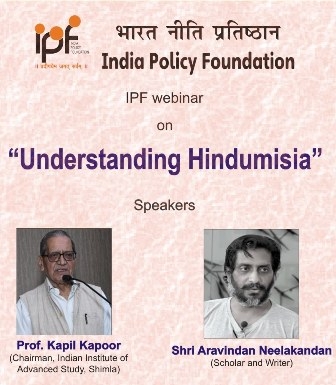
Speakers:
Prof. Kapil Kapoor (Chairman, Indian Institute of Advanced Study, Shimla)
Shri Aravindan Neelakandan (Scholar and Writer)
Moderator:
Dr Kuldeep Ratnoo (Director, India Policy Foundation)
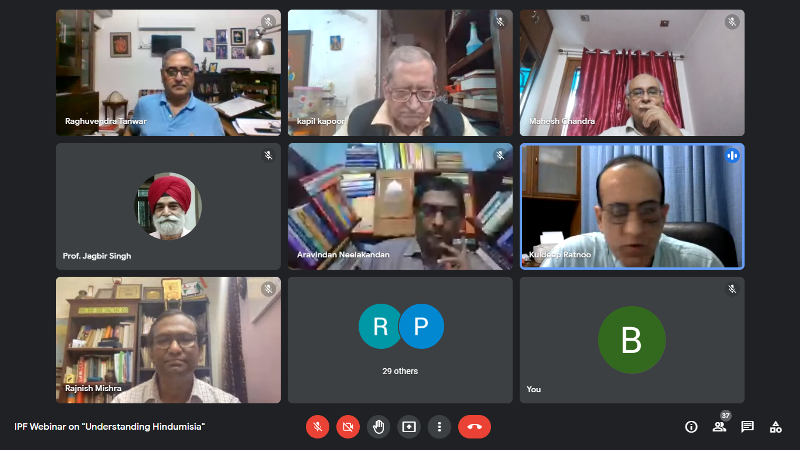
Dr Kuldeep Ratnoo:
Namaskar! On behalf of India Policy Foundation, I welcome you all to today’s webinar on Understanding Hindumisia. We are privileged to have two eminent scholars as speakers for this important webinar: Prof Kapil Kapoor and Shri Aravindan Neelakandan.
Professor Kapil Kapoor is the Chairman of Indian Institute of Advanced Study, Shimla. He is a globally renowned scholar of linguistics, literature, religion and Indian Knowledge Traditions. Before IIAS, he was Chancellor of Mahatma Gandhi Antarrashtriya Hindi Vishwavidyalaya, Wardha (Maharashtra).
Prof Kapoor worked as Professor of English at Centre for Linguistics and English, and Professor of Sanskrit at Centre for Sanskrit Studies, Jawaharlal Nehru University, New Delhi. He also served as the Pro-Vice Chancellor of Jawaharlal Nehru University.
During his research and teaching spanning nearly six decades, he has mentored many doctoral and research scholars who are contributing as academics, administrators, and policy makers. He has been a visiting professor and speaker in many universities and conferences around the world. He is an editor of Sahitya Academy sponsored Encyclopaedia of Indian Poetics, a UNESCO project; and Editor-in-Chief of Parmarth Niketan/Indian Heritage Research Foundation (USA) sponsored 11-volume Encyclopaedia of Hinduism.
Prof Kapil Kapoor has also several scholarly books and research papers. He has addressed innumerable seminars, webinars and conferences on varied issues concerning Indian Knowledge Systems and Traditions.
Our second speaker, Shri Aravindan Neelakandan is a renowned scholar and writer. At present, he is member, Auroville Board, which is Auroville Foundation’s governing body.
Aravindan Neelakandan comes from a family of scholars from Tamil Nadu. Both his parents worked as professors at Travancore Hindu College in Nagercoil.
With Shri Rajiv Malhotra, Aravindanji co-authored “Breaking India: Western Interventions in Dravidian and Dalit Faultlines” in 2011 which made a huge impact on Indian academic and political thinking. ‘Breaking India’ explores the historical development of fabricated fault lines threatening the unity of India. Other books authored by him in Tamil explore culture, history, science and technology.
As the contributing editor of Swarajya magazine and portal, he focuses mainly on culture, science, philosophy of science and history. He has written several articles and essays in Tamil and English for various publications and portals. He also serves as a mentor to the Srishti Madurai, which involves academicians and Independent scholars from universities around the world.
Aravindanji has a master's degree in psychology from Madras University and in economics from Madurai Kamaraj University.
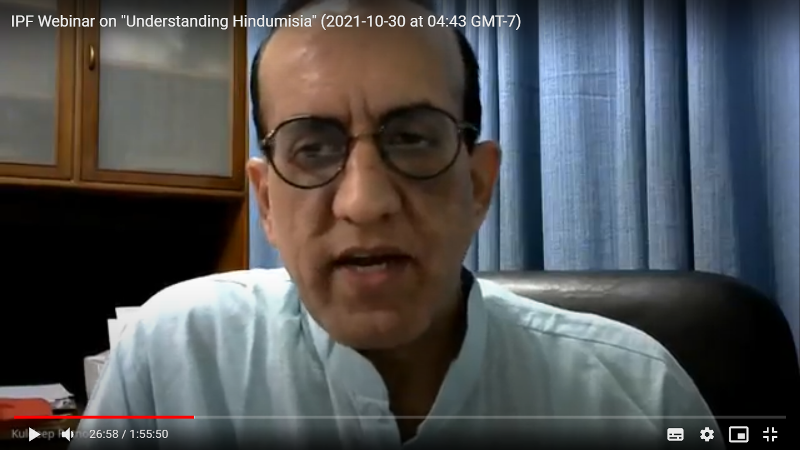
Once again, I welcome our eminent speakers today and also the prominent academicians, researchers, journalists, social workers, writers and others who have joined this webinar today.
Now, coming to the topic of our webinar, Understanding Hindumisia, the first question that comes to mind is what exactly we mean by Hindumisia. In recent times Hinduphobia has been used for prejudices, aggression and denigration towards Hindu beliefs, Hindu culture and Hindu civilisation. However, phobia indicates irrational fear. But nobody is afraid of Hindus because they have always been the most peace-loving people. Then how do we explain the widespread hatred and contempt frequently expressed by Christians, Muslims and Communists against Hindu beliefs and culture. Hindumisia, which means “hatred of Hindus that is rooted in some doctrines”, seems to be more appropriate term, in place of Hinduphobia, to explain the reason behind negative propaganda against Hindus.
However, we need to understand the origin of Hindumisia, the reasons behind it and how it has become a cause of concern for peace-loving Hindus everywhere.
We have two learned scholars with us today to guide us and I first request Shri Aravindan Neelakandanji to share his views and insights for the benefit of all of us.
Shri Aravindan Neelakandan:
Thank you for inviting me to be part of this webinar on a very important topic.
The West has been writing about Hindus, their beliefs, customs etc for a long time and claiming that the Hindus were kind of xenophobic people in modern terms. What is very interesting is that this particular thought is getting repeated by modern historians as if it is a statement of fact to describe some kind of mental deficiencies of the Hindus, that the Hindu culture is xenophobic and that the Hindus consider themselves as superior when theirs is all vain glory. So, this kind of description of the Hindus that comes throughout in history is the basis of Hindumisia at one level. We have to look at a parallel phenomenon to understand this clearly. Unfortunately, Hindumisia has never been properly documented or properly studied. Fortunately, we have a parallel phenomenon that has been very well researched and clearly studied, i.e., anti-Semitism.
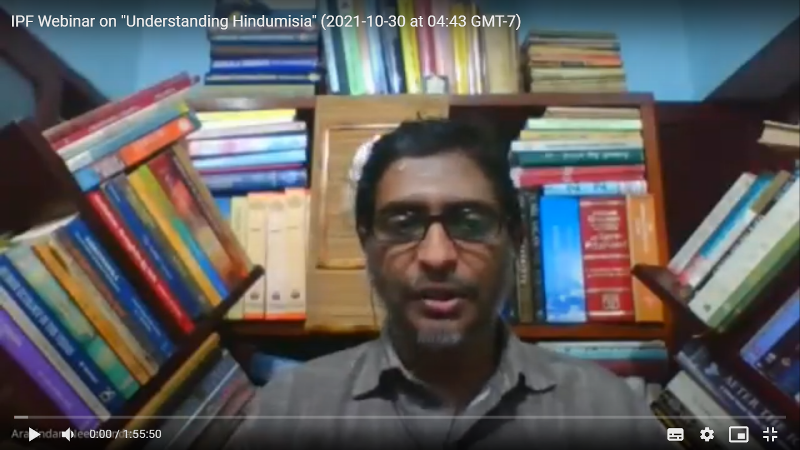
What is the similarity and difference between Hindumisia and anti-Semitism? Both Hindumisia and anti-Semitism are theological views based. The very presence of Jews in a way negates the prophecy or the mission of the two great religious leaders who came after. So, when Jesus claims that he is the Messiah and when Muhammed claims that he is the last Prophet, they negatethe very presence of Jews as a nation and Jews as a great ethnic group. So, their followers created a negative label for the Jews and stereotyped them. This has been going on for 2000 years. So, anti-Semitism is there because of a theological view towards the Jews. The same is the case with Hindus. All those who have recorded the history of Hindus and the nature of Hindus have said that it is a wonderful civilisation. These people are ethically and morally very good but they are idol worshippers. Now, theologically, idol worship is the basis of all sins and corruptions for them. But here you have a nation of people who are worshipping idols and who are leading a civilised life and who are able to contribute to the human civilisation. How do you understand this?This is the theological basis of Hindumisia. So, you create a lot of historiographies where the Hindusoriginally lived in anEden without corruption and because of priestcraft, they got corrupted into idol worship. This is the basis of the Aryan invasion theory in its essence.
As I come from Tamil Nadu, I know this very well. Because of the Dravidian utopia that they dream about which existed in Harappa and Mohenjo-Daro, they were no idol worshippers and they were no priests. It was a kind of an egalitarian utopia, a kind of a social equivalent of Eden into which came the serpent of the Aryans and they gave this fruit of wisdom which consisted of idol worship and Advaita and caste structure. Because of that the entire nation got degraded. This is the basis of Hindumisia. From the theological core, you create a historical interface and from that historical interface, you create a lot of branches in social sciences. If you take any social sciences book in India, you will find this. You will find something about the Brahmin and the non-Brahmin, the Dalit and the non-Dalit, the Aryan and the non-Aryan. The basis of all this is that the Hindu system is essentially oppressive. Whatever maybe the great achievements, under this system, there is oppression.
So, you have created a system and a framework through which you can look at Hindus as kind of deficient human beings. This is the most important thing. You can look at the same person.When he is looked as a Dalit, he is a complete human being. The same when he is looked at as a Kashmiri pandit, he is a complete person. But if you look at that person as a Hindu, then that person is humanly deficient. This is the basis of Hindumisia in a way. What happens is that you talk about Kashmiri pandits getting massacred, the Jamati as getting massacred in Tripura, the Reangs being in refugee camps in sub-human conditions for decades. What is the connecting point in all this? They were all Hindus and they are all getting persecuted and massacred because they are Hindus. But that particular aspect will not come out forcefully. Even those who are sympathetic to the Hindu cause, mostly they will refer to the Kashmiri ethnic cleansing as the ethnic cleansing of Kashmiri pandits. This is a very subtle game they are playing. It is the ethnic cleansing of Hindus. This ethnic cleansing of Hindus or I would say, the holocaust of Hindus has been happening in Pakistan and also Bangladesh. But it has been happening in slow motion.
Remember that the Nazi holocaust was not a particular event, it was the culmination of 2000 years of anti-Semitism. And what is anti-Semitism? It was not the blind hatred for Jews. It is slowly creating the stereotypes of Jews in various levels. In sociological studies, if you study Karl Marx, you will find that he was a Jew who got converted to Lutheranism when his parents got converted to Lutheran religion. When somebody gets converted to another religion, he has a visceral hatred for his parent’s religion. If you carefully go through the writings of Karl Marx, you can find anti-Semitism. But that anti-Semitism is put in secular jargons. The same way in India, there have been conversions. The visible conversions are to Christianity and Islam. You can leave that out. Then there are conversions into doctrines, Macaulayism and Marxism. When they get converted to Macaulayism and Marxism, then they develop a very strong hatred for whatever that is Hindu. And then they accept these theories that characterise Hindus as morally deficient, ethically deficient and hence naturally humanly deficient. So, if Kashmiri Hindus are getting ethnically cleansed, you can always expect the entire system to come out with a particular framework within which that gets justified in secular terms.
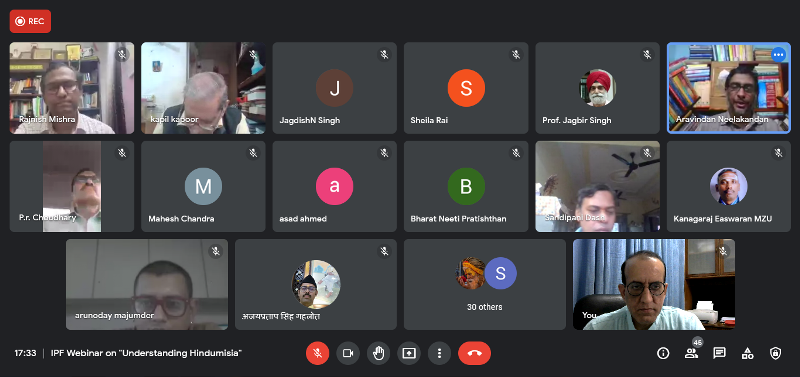
In the case of Tripura Jamatias, you will find this very clearly that they are getting massacred because they are following Hindu rituals. And there is a fatwa laid by National Liberation Front of Tripura (NLFT) which is supported by Baptist church. It says that you should not celebrate Makar Sankranti. When the Jamtias try to celebrate Makar Sankranti, they go and massacre these people. They are getting massacred not because they are Jamatiasor they speak a particular language,it is because they decided to celebrate Makar Sankranti which is a pan Indianand hence a Hindufestival. Makar Sankranti is celebrated throughout India yet nobody reacts to it. Why? One of the reasons is that we are told again and again not to identify our culture or its salient parts with Hinduism. We are told not to identify our culture with Sanatan dharma or Hindu dharma. For example, in Tamil Nadu, we are told that the salient parts of our culture should be identified with the Tamil identity and not with the Hindu identity. We celebrate Makar Sankranti but it is called Pongal. These are the regional variations of the same national and spiritual theme that is celebrated throughout India. Yet we are told that Pongal is totally a Tamil festival. So, when somebody gets killed for Makar Sankranti somewhere, I just cannot feel it as if they are my own. The same way, you can say that in Karnataka, you will have Kannada Mathe and it is called the Karnataka culture. So, over the last 150 years, we have been given these linguistic sub-national identities and we are told that our culture is essentially this linguistic culture.
Dr Nagaswamy who is a great archaeologist told one thing very beautifully: there is no such thing as a Tamil culture, there is culture in Tamil. What is this culture in Tamil? It is the Sanatan dharma’s culture. There is no such thing as a Kannada or Malayali culture. There is only one culture that we have in India which is the Hindu culture which has infinite variations but the core is the same. It is the core that is hated on. Hence, we are told not to identify with this core. So, we create these artificial constructs – Tamil identity, Kannada identity, Hindi identity etc. Then there is also this victimhood identity. I am a Brahmin or I am a Dalit or I am an OBC or I am an MBC. Note this very carefully, look at the paper reports. Whenever, there is a problem between the schedule community and the dominant community in a village, how do they report? They report caste Hindus. There alone the terms ‘Hindus’ are used. When there is a caste atrocity, they use the term, caste Hindus. You are told not to identify with the Hindu identity except in negative circumstances. So, this is the media representation, academic representation and the political representation.
Naturally, everybody hesitates to use the ‘H word.’ The result is that a lot of things get accomplished by anti-Hindu forces. For example, you take the 1971 genocide which nobody talks about as a Hindu genocide. Had it happened to any other religious groups, it would have been highlighted very strongly. But it has never happened. Take another example. A very important example in my opinion is the Uganda ethnic cleansing of the Asians by Idi Amin. He told all the Indians to leave.But to this day, more than 25,000 Indians are unaccounted for. A lot of these Indians got settled in the UK and the United States. Yet 25,000 or more than 25,000 Indians are unaccounted for. Most probably, they were killed. Think about it. There is not a single novel on them. There are lot of novels, lot of movies about NRI Indians, their lives, the problems they face etc. And if it is to enter the curriculum, then the particular person will have to write about caste atrocities which will be given a lot of coverage and that person will become a lecturer or a professor in a leading American university. But here are more than 25000 Indians who are unaccounted for during the Asian ethnic cleansing by Idi Amin. There have been a lot of movies and novels about Idi Amin and his atrocities but nobody talks about these 25,000 Indians. Even a non-fictional book is not there about this particular phenomenon. Why,because this is a tangible result of Hindumisia. Because these people were Hindus ultimately. So, their deaths don’t matter to the world that is dominated by three important monopolistic religious systems – Christianity, Islam and Marxism. From their point of view, the very presence of Hindus negates their worldview. Because Hindus show that a pluralistic, really democratic, spiritual culture can exist and thrive and contribute to the world. That is something they cannot accept. For them, it is only through a particular ideology, a particular textbook, a particular theology, a particular Prophet which will help you attain salvation and liberation. They very presence of Hindus negates this. Because of that they think that Hindus should be cured of Hinduism. If you become a Christian or Muslim, you are accepted. Even if you become a Buddhist, you are accepted. But if you are a Hindu, then you are not accepted.
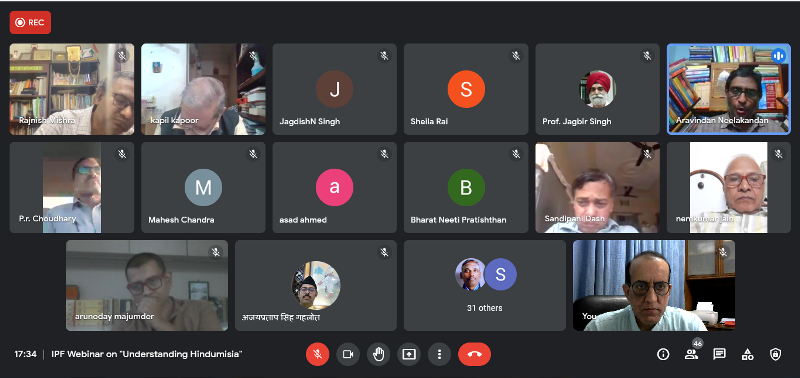
There is also another one reason for Hindumisia. The primary reason is theological and ideological. The next reason is what Alan Watts who is one of the important new age popularisers of Hindu-Buddhist dharma in the West has said in his autobiography. He said,every person who has attained a spiritual experience in the West understands that this experience is validated by incomprehensibly old Hindu system. But he does not want to acknowledge it. When this happens, naturally it becomes a kind of inducement to Hindumisia. So, you will find mostly these spiritual types in the West who actually should be pro Hindu taking a completely neutral stand or taking a kind of a Hindu aversion stand. Even those who make a living by using those Hindu systems, say in Ayurveda or in Yoga, you will find that they are opposed to use the ‘H-word.’ Their aversion to use the ‘H-word’ comes from the fact that they don’t want to acknowledge. This is only indirectly related to the theological construct that was talked before.
So, this Hindumisia has this theological core in it. How does it translate into the political aspect? Hindumisia was in full bloom in 1944. As India was moving towards independence, there was a book, ‘Verdict on India’ written by Beverley Nichols. You will find that there are passages which are chillingly same the way India gets described today. He says, “India is essentially a Brahminical fascist country” and adds that this particular Indian leader is very similar to Adolf Hitler, authoritarian and if India is given to this man, the minorities would not be safe here. And that particular leader Beverley Nichols talks about comes from Gujrat. His name is Mahatma Gandhi. Now, Gandhi is called Brahminical, he is called a kind of Hitler-like fascist threat to the minorities by Beverley Nichols. Why did this happen? The reason for the phenomenon is the same. The same thing you can see today. If India is independent, even if India is a secular India, if India is progressing even in secular domains, whether it is space or nuclear technology, then it is the triumph of a pagan culture. That is why whenever India triumphs, they cannot stand it. Think about it, China is a communist country. Yet the achievements of China which is completely based on unethical methods, completely based on totalitarian methods, those accomplishments are not criticised in the Western media,whereas the accomplishments of India are getting criticised in the Western media. The reason is because China has abandoned Taoism and it has accepted Communism which is a Western import. An Asian country accepting Communism is essentially an Asian country accepting the Western cultural supremacy.
India, which does not accept Western cultural supremacy and which claims that democracy is an Indic phenomenon; Ambedkar, Gandhi and Savarkar have said that and now Narendra Modi says it. So, this democracy is not Western democracy, this is essentially a democracy that has evolved from India’s own inner being. So, it is a pagan democracy. A pagan democracy succeeding is not acceptable as an authoritarian communist state succeeding. This is the problem of the world in accepting India. The basis is Hindumisia. So, this Hindumisia has a lot of political consequences also. But for the book, ‘Churchill’s Secret War,’ we would have never understood Bengal famine for what it is. After all, Amartya Sen had done phenomenal work on Bengal famine, but he missed this particular point either intentionally or ignorantly. It was this book, ‘Churchill’s Secret War’ that brought out the particular dimension that Hindumisia can create genocidal results. Before that in 1870s, there was a famine which killed more than 6 million people in the entire Deccan. Nobody talks about this particular famine and this famine was created with a lot of Hindumisia behind it. You can go back and read the materials to see how the evangelists saw the famine as a God given gift and how the infrastructure was destroyed by the British to aggravate and create the famine. Here you have Hindumisia that has actually created genocidal results. After that in 1989-90, we have the ethnic cleansing of Kashmiri Hindus and after that what has happened in Afghanistan, what is happening in Bangladesh, what is happening in Pakistan and what is happening in small pockets of India.Right now, within India, there are pockets where Hindu lives don’t matter. Because Hindumisia is a phenomenon which is entrenched, embedded in the code of our media, polity and academia.Hence this aspect has to be understood.
Hindumisia is a very real phenomenon that we are living under. We are like the pre-Holocaust Jews and we are not even aware of it. At least Holocaust was a phenomenon or event that happened. You could mark it. In the case of Hindus, Holocaust is a process that is happening right now. We have to understand that very clearly.
Dr Kuldeep Ratnoo:
Thank you Aravindanji. Thank you very much for insightfully elaborating and highlighting the nature of Hindumisia and the very causes and the factors behind it. You have mentioned about the theological basis of Hindumisia and you have also highlighted the political basis behind Hindumisia. This definitely is a severe concern.As more and more people are connecting with each other through social media, the intentions which are age old and are not recent phenomena, are getting exposed and people are realising why Hindus are so much hated. Thank you very much for throwing light on various aspects of the topic.
Now I would request Prof Kapil Kapoor sir to give his remarks and provide us more insights on the topic today.
Prof Kapil Kapoor:
Namaskar!
People are defined by how they think. They are defined by their thought. They are defined by their values. They are defined by their chetnaor consciousness. What kind of awareness do they have and how do they generate it?Neelakandanji has done a meticulous analysis of the dangers and fault lines that are there in our existence. I will be speaking along the same lines. I will be rephrasing and paraphrasing what he has already said.
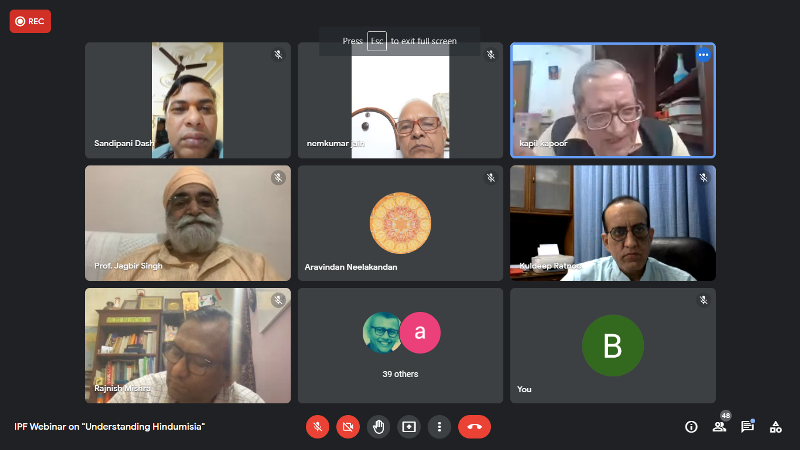
The word ‘misia’ is very interesting. Misia means misidentifying or misinforming people. So, when we say Hindumisia, we mean the criticism that is directed at the Hindu thought or Hindu society or Hindu people,is in fact a bundle of misinformation and bundle of falsehoods that are spread about us. I don’t think Hinduism or Hindus are hated the world over. Let us get away from the educated class ormedia and look at the ancient people who had come to India to visit the sites of Buddha and Varanasi, and even look at how the Indian government is treated these days. The Hindus are not hated. In fact, even in the USA where at present there is maximum synchronised attack on the Hindu civilisation, even there, India at the level of government enjoys so much respect. And many of their CEOs of major companies are Hindus in America. We have to remember this. Perhaps there is a danger of paranoia. Especially because of the newspapers and social media, the negative things get focussed. Recently we heard of 40 universities coming together and dismantling Hindutva. The event is over and did Hindutva get dismantled? On the other hand, people who took part in this conference got dismantled because the universities that they had associated themselves with dissociated from the event and told them not to use the university logos. So, in the effort to dismantle Hindutva, they dismantled themselves. So, let us not get paranoid and let us start looking at things objectively.
The danger to our people comes from both outside and inside. But more importantly, I think the danger is inside. The NRIs in USA and other places also have a feeling of being victimised, persecuted and loss of confidence as if the Hindus are losing the battle and there is no future for Hindus. Let us look at the factssquarely.
I will say a few things about Hinduism and Hindus which all of us will agree are true. For example, we are one people in this country. No outsider who came to India from Herodotus who wrote ‘Histories’, to Hiuen Tsang or the other Chinese travellers who came later, or the 16th century European travellers, no one was ever in doubt that India is one countryin spite of all its internal deviations and variations. And it is in fact a different country which is a kind of example for people. Diodorus Siculus who came to India in first century BC says, “The Hindus have very unique laws and one of their laws is no man can be a slave to another.” Compare this with Aristotle’s Politics where slaves are the fifth part of the state, an accepted part. And from thirdorfourth century BC right up to 1836 when Abraham Lincoln abolished slavery,for 2200 years, the entire western civilisation thrived on slavery. And we are a people who said before the second century BC that no man can be a slave to another.
Let me say a few things. We are one people. People ask me whether India is one country or are its people united;who are Hindus, whether Hindus are one people. I will give the example of 13th century. Namdev who was the disciple of Gyaneshwar but was older to him, when Gyaneshwar took samadhi by incinerating himself alive, Namdev was disheartened and went from Pune to Punjab. He lived and died in a village called Ghuman where his banior his compositions are available first only in Guru Granth Sahib and not in Maharashtra. If this was not one country and if this was not one people, how is it that a person from Maharashtra in 13th century goes thousand miles away to another part and is remembered and quoted.
We are one country and we are one people. No outsider had any doubt. Look at the Roman map of India and the Vishnu Puran description of Bharat Khand and you match these and you have the vrihad Bharat where Burma is a part of India and also parts of Afghanistan, Pakistan and also eastern Iran. Our word is Desha, land mass, from the Himalayas to the ocean, from the Sulaiman mountains to the green mountains of Myanmar. This is a country which god has defined geographically.
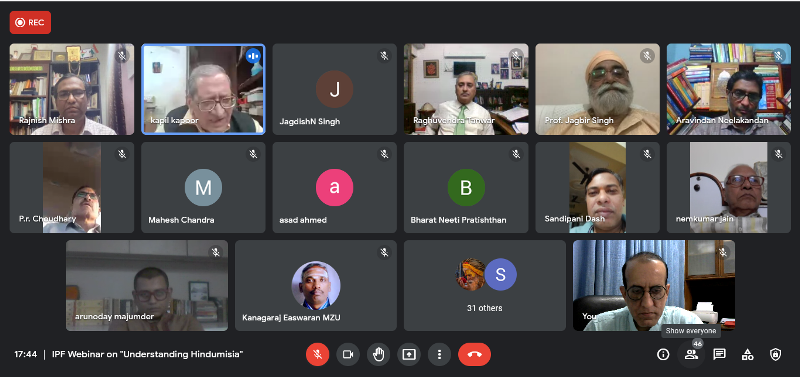
We are the only civilisation out of the 46 human civilisations that has survived for 10,000 years. All other civilisations disappeared. We have survived because from day one, we had enemies. When there were enemies or opponents, then from within our people rose the great defenders, the fighters and the thinkers who resuscitatedand reconstructed, reconstituted the knowledge and the morale of the people. Look at Guru Nanak. Babur invades India and carries out a massive massacre. Guru Nanak who is a sadhu has the courage to write a long poem on the massacre naming him. Therefore, it is such people who kept this country and the morale of peopleintact.
Thirdly, we are a peace-loving people. Armies have never marched out of India. But ideas have always marched out of India. The so-called Silk Route was in fact an ‘idea route.’ Buddhism spread across Asia along with the Silk Route.
Most importantly, we believe that not only humans but all Jeev, all living beings are equal. We see people feeding ants, feeding birds. This is our fundamental belief. We are all particles of the great divine. We have respect for all life. You can call it pluralism, plurality or whatever you may like. These are given. These are the truths about India. Therefore, whatever is being said about it in the opposition is all ‘misia,’ it is all misinformation and misidentification. Therefore, it is motivated and deliberate.
The attacks on Hindu civilisation are basically a game of the Anglo-American world. It started in the early 19th century when Britishers brought their liberalism to India. And some of the educated Indians sold themselves to this liberalism, like Raja Ram Mohan Roy whose great ambition in life was to be buried in England. Of course, he was buried in England and then his bones were brought to India and they are buried in a Christian cemetery. The liberalism became the weapon of attack. But they have attacked different things. They have attacked the Hindu thought. But you must remember one thing that all this is motivated. Therefore, to believe, you have to see why they are doing it and the methods they are adopting. We have to counter that and we also have to realise the proportion of this. If you go hundredkilometres out of Delhi and if you talk to a man smoking hookah, he doesn’t think that India is being abused and misrepresented. For him, there is no Hindumisia. Although he doesn’t know what is a Hindu, which is one of the problems. The Hindus suffer from self-ignorance. Who are we? If you go to Haryana and ask someone what is a Hindu, they will tell you that it means not to break a temple, not to kill a cow and to worship Krishna. This is Hinduism for them. So in Haryana, in many villages, the slaughterhouses were opposed by the people.
We are a different people, and the different people are generally disliked by others. It is not us; it is they who suffer from an inferiority complex. Those who are attacking Hinduism are the ones suffering from an inferiority complex. In fact, they are afraid that these people are morally superior and they are an alternative and what that alternative stands on is a danger to the very foundation of civilisation which is based on violence, domination and money. These are the three foundations of western civilisation beginning with the Old Testament. In Book of Genesis, God tells Adam: “I have made you in my own image. The birds of the air and the fish of water are for you to enjoy, exercise dominion over them.” If you enjoy a bird, you kill it. Killing, domination, power over others, this is the foundation. Power is closely related to money and finance and therefore, trade. All this globalisation was nothing but building a global market.
If we take the criticism seriously, let us identify our dangers. The number one danger is that we Hindus are ignorant of who we are. We don’t know what we are. We have been dislocated by our education from ourselves. If you ask a Hindu about Shankaracharya, Ramanujacharya or Hemachandra, they would simply say that they were sages, who wore saffron clothes and were highly learned. They keep talking about Vedanta, but even professors do not fully understand the philosophy. They are not even aware of the teachings of Vedas or our thinkers. It is not their fault. It is the outcome of 200 years of Shastraik domination, the idea domination by the British through their education policy which was very simple, EEE – English, Education, Employment. That has cut us off. So, the first danger to Hinduism comes from the ignorance of Hindus about themselves. It is like Hanumanji forgetting his power due to a curse and Jambavantji had to remind him of it. We are all suffering from the Hanuman syndrome. We have forgotten who we are and that is our greatest danger. First, we must realise ourselves. We had a shastra dharma. Al-Biruniin 11th century, who came with Mahmud Ghazni, writes that the Hindus are different from us in three ways – 1) A Hindu is not afraid of death, 2) A Hindu always speaks the truth and 3) A Hindu is very proud of his knowledge. This was in 11th century. Today, in the 21st century, these observations no longer hold true. Now we accumulate wealth for several coming generations, we no longer speak the truth and we don’t trust our knowledge, all the knowledge is from the West. Texts from West are taught in all schools and colleges. We don’t teach our shastra, our granths. We have to know who we are. We must realise that if we don’t understand who we are, then we will never be able to defend ourselves. You will defend only when you think that you are worthy of defence.
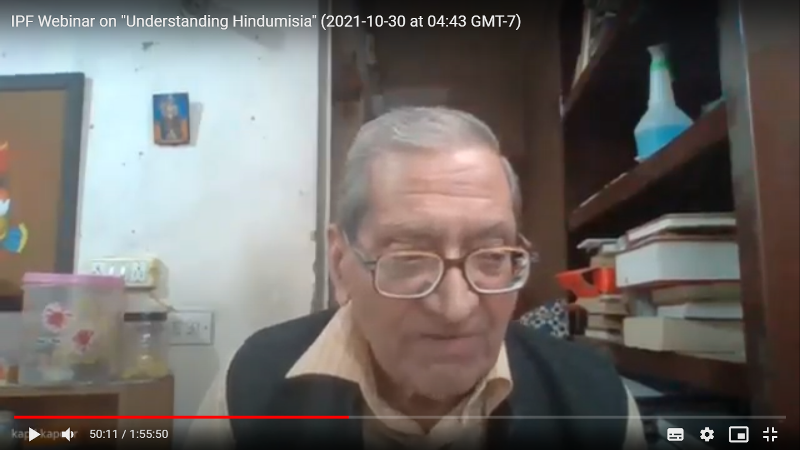
The second danger that our people face from is proselytization. Why is it that a way of life which does not proselytise is being forced to convert either under threat or by showing the greed for money? Hindus don’t convert others, then why others are given permission to convert us. Under Islamic tyranny, many Hindus were converted to Islam using sword. Then Christians started conversion through sword and money. Now our governments are allowing conversions. In the year 2000, I met an Archbishop who claimed that he respected all religions, soI asked him then why Hindus who do not proselytise are being proselytised. He couldn’t say anything about why proselytization was encouraged.
The third danger is that our state is perceived as a weak state. Since we are not aware of our roots, we are unable to defend ourselves. When people reduce Hinduism to casteism, we do not have enough knowledge to say that our varna system which does not discriminate, is not caste system. In fact, Caste is a Portuguese word and can never be applied to the Indian milieu. In my 82 years of life, I have not seen a single instance of untouchability, in my part of India. The system of untouchability is not part of the varna system but we cannot defend it as we are not aware of it. For long and till the present dispensation came, I am being very categorical, our state was a subverted and sabotaged state. It was like a Dharmashala. People could come from anywhere and settle here, spread terror through bomb blasts and still roam free since courts would take decades to settle a case. There was absolute lawlessness and there was no fear of the state. That is why our state is perceived as weak. And that is transferred to the Hindus and they are perceived as weak. But Hindus are not weak.
Karl Marx in his notes on Indian history asks a very good question. He asks how is it that the valiant Persians were defeated and converted by the invading Arab armies within 30 years?How is that it took 400 years for the Islamic armies to reach Delhi from the borders of India which is about 990 km? Every inch was fought, every inch, and there was not a time when somebody was not fighting somewhere. It was not easy.Therefore, we are not a weak people at all. Our state is weak and that weakness is transferred to the people. People are not weak. In 1962 war, because our soldiers were in tennis shoes, more soldiers died of frost bite than of bullets. But in 1967, when the Chinese attacked from the Nathu La pass, Indian army fought with bravery and forced Chinese to retreat. We are not weak people. But if the state does not protect or give arms to its soldiers and if an army man who fights for the honour of his country and his colleagues, is charged by the state in the court of law, then why will he fight? So, it is the state which is weak. It is the state which is perverse. And state has to be corrected and I am glad that it is being corrected.
Now what is the attack on Hindu thought? The attack on the Hindu thought is that the Vedas are a rhapsody of names,they are written by foolish people and are devoid of any meaning. It was easy to say this for people who were not native speakers of Sanskrit language. As the SankhyaDarshan says the Vedic language is roopakor metaphoric. The attack on thought is that all Hindu thought is other-worldly. Nothing can be farther from the truth. Hindu texts are scientific and empirical and they are totally grounded in facts and reality, based on enumerated data. You have to make the distinction between Veda and Shastra. Vedic thought is speculative philosophy and the Shastras are empirical sciences. Even our gods are not other worldly. Ram and Krishna lived amongst peopleas ordinary individuals and went through a lot of hardships.
The other attack is that we lost all battles. We are not aware of the facts because of which we believe the propaganda that we are cowards. We need to understand that even when we talk about 181 years of Mughal rule, but we don’t talk about 10 Sikh Gurus whostood as a barrier to the Mughals. In comparison to Mughals, Cholas ruled for 800 years, Mauryas for 400 years, Guptas for 300 years and the Pandyas, Satvahanas and other dynasties have also ruled for a long time. Gautamiputra Satakarni in 78 A.D goes from Nashikto Sindhu River and defeats theSakas, the Scythians. Where was India weak?
Coming to the Abrahamic religions argument that was addressed by Neelakandanji, the main problem with those religions is that they have only one God and that is formless. But it is not attributeless. That is the fault line in the Abrahamic God. It is formless, but not attributeless. That is why the Judaic one God, the Christian one God, and the Islamic one God, are different from each other. So, it is one God but my God and not yours, so it ceases to be one God. They are a book worshipping people. They are Bibliolatrous people and we are Idolatrous people. They worship books and we worship idols. Theydisavowidols as nobody has seen what god looks like. Nobody had seen Hanuman ji. But they forget that even an idol of Hanumanji can be made in thousand forms. Hindus never deny that we make our own idols. We even worship stones. We think differently. For us, god is real and there is no god. For Hindus, there is no god with a capital G. All are gods and goddesses, Devis and Devtas. We have nirakaar and we have sakaar. We have nirgun and we have sagun. Abrahamic God is claimed to be formless but it has representations. For example, in the Son of God, Jesus’ image is a representation in Christianity. In Islam, the arc and the minarets are the representations. Visual representations are made of secondary representations, but the concept of God is formless and one. The Abrahamic God is formless, but has representations and is not without attributes. The logical fallacy is that a formless God has qualities, attributes.
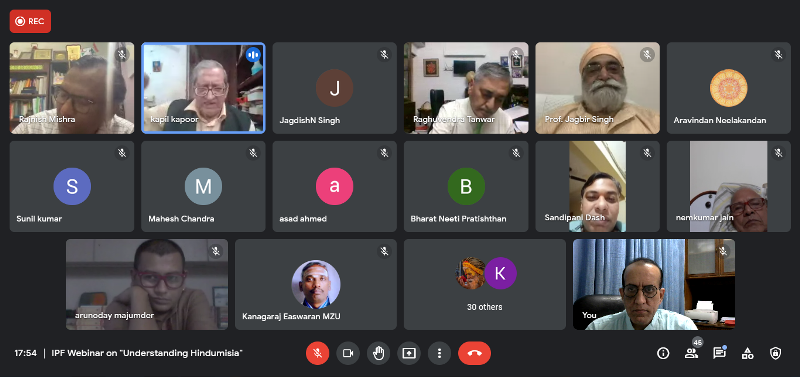
Our children who go to schools are taught that God is one. But Hindus have so many gods and goddesses and they worship stones. They (Abrahamic) are the people who believe that an image is a corruption of the mind. But as Plato pointed out long back that what you consider as real, what you see as real, even that is an image and is not the reality. So, there is a fundamental,ontologicaland epistemological difference in the two civilisations. And because we are not a one God people, we are tolerant, we are multiple, we accept different points of view and our unity is not in terms of a God, not in terms of one mode of worship, not in terms of one goal of life but it is a unity of consciousness. Chetainya ki ekatmata hai. We have an awareness of all these things. There is a truth somewhere but there are many ways of expressing it. There are values of life which are unquestionable. There is no question of compromising with values like kindness, empathy, charity, patience, forgiveness etc. In Mahabharata, Yudhishthira tells Draupadi that he learnt from his forefathers that forgiveness is the greatest dharma. And this is almost 5000 years before Christ. Yudhishthira tells Draupadi that I know I am right and Duryodhana is wrong, therefore I am able to forgive him. We are value loaded and our civilisation is knowledge centred and our society is duty oriented. Our unity is the unity of chetna. Our identity is Sanatan Dharma. At one time, it was Sanatan dharma all over the world. You find Shiv lingas in Egypt and Asia. Wherever you dig, there is either a temple or an icon of the Sanatan Dharma. Why only symbols and icons of Sanatan Dharma are found everywhere? This is because it is the oldest in the world. It was the Dharma. It is the natural way of life. That is why they say that Hinduism is not an organised religion, it is a way of life.
Moving out, disowning is another issue. Some Hindus claim they are not Hindus. No problem, but then who are you? A deadwood is better falling off the tree. If someone doesn’t know who heis, how that person will defend himself?There are many criticisms against Hinduism and it is claimed that Indian society is an unequal society. Caste is often equated with race in India which is wrong. It is often said that India’s is a violent society. Please note that a civilisation which eliminated 17 million Red Indians by syphilis and by bullet, a civilisation which eliminated 36 million Mexicans, a billion Bisons which used to roam the prairies of Canada and America,and over history of 2000 years, eliminated over 50 million Jews and the great modern civilisation set up factories from 1942 to 1945 to kill five million Jews, and they preach us equality, they preach us tolerance and they tell us that your society is unjust. How many genocides we committed? Hindus have been the victims of genocide. During 12th to 15th century, Hindu population fell in this country by 40 per cent. 80 million Hindus were exterminated or eliminated from 11th century onwards. Read Will Durant’s Story of Civilisation. The Islamic conquest of India is the bloodiest chapter in its history. And the West transfers their guilt complex to us. By West, I don’t mean all West. It is mostly Anglo-American, and more in American universities. But their government or corporates don’t think like this. So, let us not get paranoid about it.
They allege our festivals are all polluting. Only our festivals are blamed for pollution. Our own judges claim this. But New Year celebrations don’t create pollution. We cannot blame others when the educated class itself behaves in a particular manner. What kind of educated class we have produced and what kind of people we have chosen to rule us? We have put people who have trained in the western system, for whom India is a backward and orthodox country and a country which needs to be reformed. Social engineering is required because they don’t know these things.
Our symbols are termed fascist. Swastika is termed a fascist symbol. They don’t know that it is a symbol of Jains. Jain dharma is the most peaceful dharma. The culmination of civilisation is Jain dharma. Jains believe that even stopping the natural flow of water is violence; not allowing a tree to grow naturally is violence. And their symbol has become fascist?
Our national heroes are ridiculed. Maharana Pratapis presented as someone who did not let Akbar unify the country. Guru Teg Bahadur is denigrated. We teach all this to our kids in textbooks. Savarkar is presented as someone who used to write apology letters without telling the facts about his long suffering in prison. We all know who killed Mahatma Gandhi but we do not know who killed Guru Teg Bahadur or Guru Arjun Dev. So, we do not have enemies outside. We are our own enemy. Bhagwad Gita says your Self is your friend and your Self is your enemy. Hindu icons are great only if there is a commercial value attached to it. For example, rangoli is seen as a waste of time if done by women but the moment it has commercial value in the market, it becomes something good. So, if you do something without any commercial purpose, you are foolish.
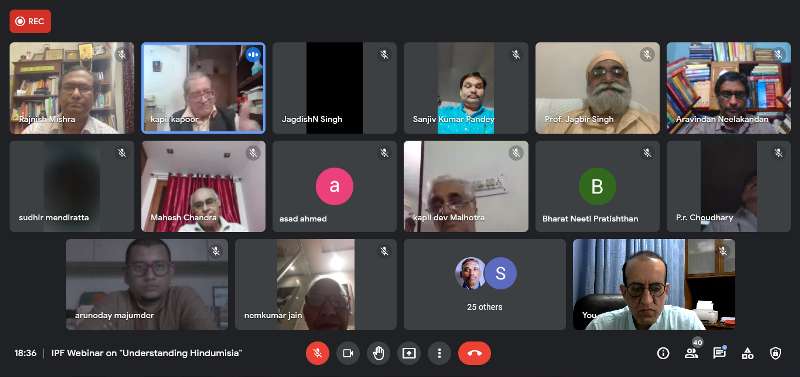
The genocide of Mexicans, Red Indians and Jews is the truth of the civilisation which is giving us lectures. Genocide is an inherent feature of their religion and they keep transferring their guilt to us on every small incident. Inequality can befound in any country. Indians are treated unfairly in western nations, even at their airportswe are treated as suspects while we consider them as our guests and treat them well.
So, Hindumisia is misinformation. It is a game of the educated section of people, particularly the Anglo-American world and it is directed at the Hindu civilisation. This is because Hindu civilisation is the alternate civilisation to the contemporary western civilisation. And they are sacred of the alternative. They are playing a political game. The leftists want to establish the leftist kingdom in India and the Islamist want to establish a Ghazwa-e-Hind. And that too not all of them, only some.Only the religio-political types. The ordinary Muslim and Christianis like an ordinary Hindu. It is the class which is vocal, which gets printed, which speaks on the television which gives the impression that all Muslims think like this, all Hindus think like this and all Christians think like this. It is not so. We have to be discriminating and we should not have any paranoia. We have a long history; we have a long memory and I am sure that we will continue to survive.
Thank you very much!
Dr Kuldeep Ratnoo:
Sir, thank you very much for your detailed and enlightening discourse on various factors which sustain Hinduism and SanatanDharma! And why we are different and why we are superior to the people who cast aspersions on Hinduism, SanatanDharma, on our culture and our civilisation.
Prof Kapil Kapoor
I will intervene for a moment. Today, it may feel like Tamil Nadu is on one side but Tamil Nadu is the citadel of Hinduism. We have four major cities. In that, Chennai is the city of Dharma, Mumbai is the city of Artha, Delhi is the city of Kamaand Kolkata is the city of Moksha. Chennai has the oldest temples in India. In Tamil Nadu, great dynasties came up one after the other. Even today, you will feel far more peaceful if you go to live in any of the villages or cities in Tamil Nadu compared to any other places. In the neighbouring state of Kerala, its famous temple Padmanabhaswamy temple conducts an annual pooja. In that Communist run state, twice in a year, the Trivandrum airport is shut down because the masses move through the airport for this pooja. It does not happen anywhere else in India. Kerala may be a problem state now but they are carriers of the heritage of India and it cannot be denied. SreeNarayana Guru is still a source of inspiration to people. Bhagavad Purana is still recited in villages. If you go out of the cities, the country remains more or less unchanged.
Q&A session
Dr. Asad Ahmed: My question is to Mr Neelakandan. M.K.Stalin is going from one controversy to another. It has been in the news recently that he is going to confiscate the gold that is coming to the temples. Is it true? Secondly, what kind of precedent will it set for Hindutva and other Hindu temples?
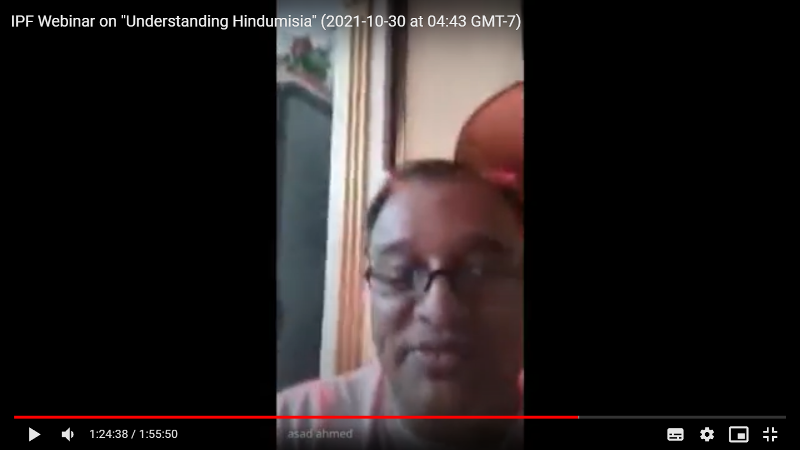
Shri Neelakandan: Before addressing this, I want to say one thing. Today you have a lot of beautiful temples in Tamil Nadu and the Vedic, musical and dance traditions have been well preserved. The reason why they have been preserved is that millions of Hindus were fighting in the battlefields in the north and they had given their lives. They stood as a big barrier and saved us from the invading forces. The Marathas, the Sikhs, the Rajputs, the Vijayanagara empire– all the sacrifices because of which today our temples are standing. We have a very rich culture which is being attacked by proselytising agencies now. That is up for another debate.
Now coming to the question. Yes, Tamil Nadu government is seriously taking this step of converting the donations made by devotees, not the King’s donations but the modern gold donations made by the devotees into gold bars. This is very intimately connected to Hindumisia. Perhaps a better term as suggested by a friend of mine will be ‘Hindu-dvesha.’ This means that they want to tangibly weaken the Hindu infrastructure. One is the gold of the Hindu temples and the other one is the land of the Hindu temples. The Hindu Religious and Charitable Endowments Department is purposefully destroying these two aspects. This is a worrisome thing and I think the High Court has put some kind of stay saying that proper auditing should be done. But then, Sarkaria Commission onwards, it has been said that the particular party is capable of doing scientific corruption. This is one of the worst accused party for corruptions but nothing has ever been proved. That has been their greatest strength. We do not know what will happen to this gold. It is very worrisome and if this continues in other states where Hindu-dvesha parties are ruling, then it is setting a very bad precedent.
Prof Kapoor: I also read news that in certain places the priests and the local people, when the government officers went to look at the collection or seize the collection, opposed them and didn’t let them do it. This also happened in Tamil Nadu in one or two places. So, the government is planning and the court is hearing the case and I think it will be sometime before it happens. The problem is not of one state, it is a pan India problem. It is only the Hindu temples which are under government scrutiny. The worship places of other religions are not in government scrutiny. All the Hindu temples have a government officer sitting there while other religions have the freedom to do whatever they want with their properties. And I don’t know why so many Hindus in this country don’t make a noise about it. The problem is again with the Hindus. So long as you don’t take Rs 5 out of their pockets, they don’t bother. You take Rs 50 from god’s pockets, they don’t care. We do not know what to defend. This is the problem.
Arunoday Majumder: About the issue regarding the Hindu temples, there is currently a case that is being fought by Advocate Sai Deepak in the Supreme Court. I also have a question. Along with threats, defence was mentioned quite often. There is no doubt that Indian universities still suffer from a colonial mindset. There is a selective outrage which is getting manifested as an internal threat. We are unable to address the provocations from the Western academia. I believe it is necessary for us to bolster our knowledge. What policies can be instituted where we have some part to play in what kind of knowledge is being produced by our journals or by our publishing houses?
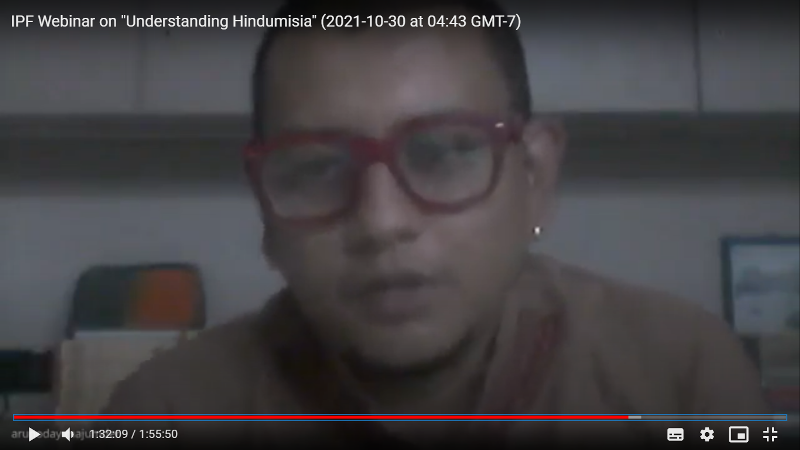
Prof Kapoor: It is a very good observation. The root of this is English medium of education. English is a language which cuts off people from their own language and their own roots. Therefore, if you really want to create a supply chain, what we recommended in the comprehensive language policy paper that was submitted to the government in 2016 was that the state language should be the medium of instruction all over India, from class I to research. We suggested that it should be done without delay just as Macaulay did it in 1835. When Macaulay was asked about the confusion that will ensue, he said confusion is for the education institutions to handle. Now you have various boards of education and in a year or two, things will fall into place. But you will cut the basic cord that ties the Indian mind to subordinating thought. And that is the only way. We have to change the medium of education. We were able to do two things in the New Education Policy – regional languages will be means of instruction up to class V, possibly also class VIII if students want it and later. India’s unity is being destroyed by the liberal education. The content of the Indian languages comes from the same Manas Gangotri and if you are teaching in Indian languages, most Indians will think alike. This is what has been happening in this country. In 1834, before the English Education Act, literacy rate in India was 97 per cent. This was because the village teacher who could be a Dalit, Muslim, Brahminwill teach all students in regional languages. After 1834, a survey was done and India’s literacy had fallen to 16 per cent. So, if you look at the education act of Macaulaywhich had five points, you will see that they wanted to produce Indians who are English in their values, thoughts, attitudes and preferences. The solution to this was not to teach Indians in their language. The solution to the question that you posed is to change the medium of instruction. There should be a loud voice for this. The government is diffident. But it is bound to come. 10 per cent of people cannot rule 90 per cent of people for all time to come.
Brig Kapil Dev Malhotra: It is true that people of India are not aware of the manuscripts that we have and sometimes foreigners make us aware of what we possess. Same is the case with regional languages.
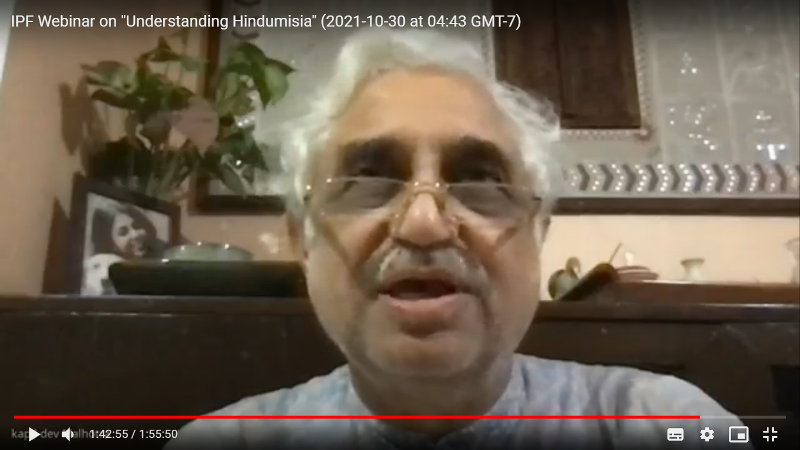
Prof Kapoor: In India, the link language always develops on its own by the dynamics of the Indian people. For long, Sanskrit was the link language, then Pali was the link language, then Prakrit, after which modern Indian languages came. Braj Bhasha was a link language for several centuries. Most of the Bhakti poets of North India composed in Braj Bhasha. And now I will give you facts. Hindi intelligibility or how many people understand Hindi in India. In 1960, 51 per cent of the people understood Hindi in India. Today, more than 80 per cent of the people understand Hindi. So, gradually a form of working Hindi is becoming the link language of the country.
Sandipani Dash: We have a terrible history of iconoclastic destruction of our knowledge traditions. Is there a chance of reversing these losses?
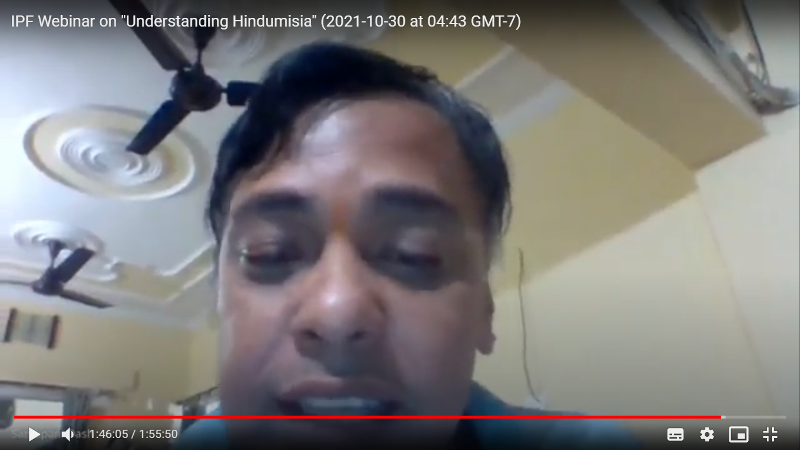
Prof Kapoor: There were millions of granthas and at present, we have not less than one million manuscripts. Although Nalanda library burned for six months, more than one million manuscripts are still there. The destruction was never total. For example, when Nalanda was destroyed, the monks did not flee with money, but they fled with books. And over 6000 books were translated into Tibetan language and now they are only available in Tibetan language. From Tibetan, they have been translated back into Sanskrit. What I am trying to say is much is lost but much remains. Ours is an oral tradition and in it, the knowledge is transmitted by word of mouth. I will quote Max Mueller. He said in 1860 that even if all the copies of Rig Veda are destroyed, you can reconstruct Rig Veda from the minds of the people. So, in oral traditions, the recovery is very much possible. I will draw your attention to one of my articles, ‘Loss and Recovery in the Indian Traditions’ where I have said how Vyasa tradition is simply a recovery tradition where knowledge is recovered.
Dr Kuldeep Ratnoo: I have a question to Aravindanji. We started with discussing Hindumisia and how the Abrahamic theology had cast some negative aspersions because of their teachings on Hinduism. The last century is of the angle viewed by the communists. The Muslims would like to expand their Islamic empire, the Christians want to convert every non-Christian. What is the interest of the communists to denigrate Hinduism?
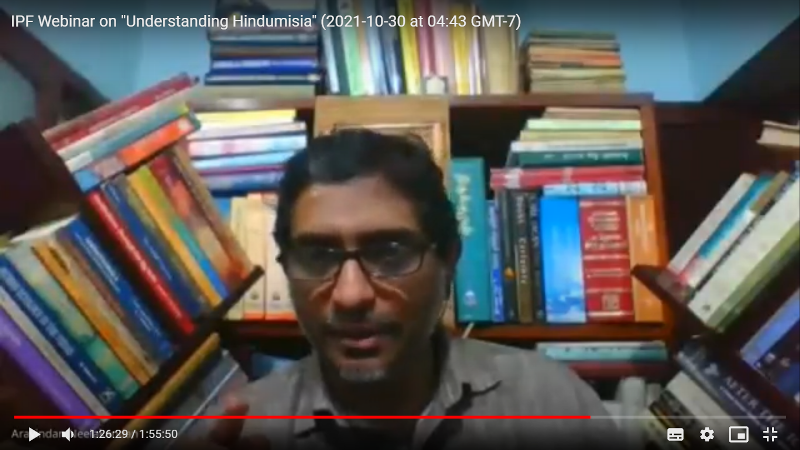
Shri Neelakandan: I would like to make a small correction when we talk about Abrahamic religions. I would like to make a difference between monotheisticreligions and monopolistic religions. Judaism is essentially a monotheistic religion. We don’t have a problem with Judaism, whatever be their scriptures. Whereas in monopolistic religion, you say that only my God is true and all other gods are false. You have to either accept the God or die and rot in hell. In this term, you have to see that Marxism is a memetic clone of Christian and Islamic theology. So, for Christianity, Islam and Marxism, in its core theology and ideology, Hinduism by its very existence negates their world view. Even if one Hindu exists, then he negates Marxist, Islamist and Christian ideology. That is why Marxism will always join hands with Islam. M.N.Roy said that essentially Islam is a progressive state and Hinduism is a kind of feudal backward state. They have this linear view of history. Just like Christianity and Islam, Marxism also has a linear view of history. So, in the linear view of history, Hinduism represents a backward state and Islam represents a progressive state. Marxism will alwaysjoin hands with Islam because in its memetic core, both Islam and Marxism are same. They both want diversity to be destroyed, democracy to be destroyed and Hinduism is essentially spiritual democracy. So, they hate Hindus. That is the reason.
Dr Ratnoo: Thank you very much! We will definitely have more webinars on topics we couldn’t touch today. It is a very wide subject and as pointed out repeatedly by both the speakers, we need to make people aware of who we are, what are the challenges before us and why we are better at helping humanity. Particularly when the crises are increasing, in terms of diversity, environment, sustainable economic system, gender justice, movement of people etc. There are plenty of issues on which Hindu civilisation provides sustainable humanitarian answers and solutions to the world. And the world is looking for those answers and we need to be proactive and discuss more. As pointed out by one of our participants, we need to again take up the issue of spreading our knowledge and taking our knowledge beyond our borders. We need to take it to their field instead of continuously defending in our field. Thank you very much for your patient listening and participation. I express my gratitude to our learned speakers today, Prof Kapil Kapoorji and Shri Aravindan Neelakandanji. I would request all participants to search for their articles and lectures on the web to gain more wisdom on diverse issues. Thank you everyone!!
***